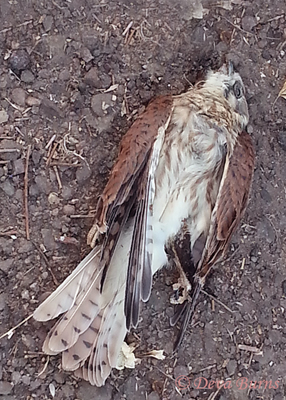
June’s oven has become August’s sauna. Lightning trips across the eastern sky, cockroaches plying their nightly trade scuttle under our backyard composter, and a thoroughly ordinary Diamondback starting rotation resuscitates opposing batters’ declining averages. The phrase “dog days of August” for sure was coined right here in the Arizona desert. If you’re feeling out of sorts until mid-October, at least you’re still alive. Many of our feathered friends aren’t! The Arizona desert is tough on nestlings and fledglings just learning how to survive in the heat.
If you’re an observant birder you’ve probably noticed, as I have, the plethora of broken eggshells and desiccated carcasses littering Arizona streets and yards during July and August. This morning on my way out to our driveway for the newspaper I picked up a dead juvenile European Starling, a dead young Verdin, and the wing of a White-winged Dove. Yesterday on her morning walk, Deva found a dead Lesser Goldfinch and two dead White-winged Doves, this a week after photographing a dead juvenile American Kestrel with her cell phone.
These discoveries reminded me of the summer of 2012 when we found five(!) dead Anna’s Hummingbirds, all immatures, in our yard in the space of a week. Coincidentally enough, on my bicycle commute to work this morning after I had written the opening paragraph of this column, I came across the carcass of a fledgling Harris’s Hawk.
Years ago, in an article in Auk about nesting success of altricial birds, M. M. Nice estimated the average mortality rate among passerines is 50%! I’m guessing in the heat of Arizona’s summer as we all wither in the throes of a fifteen year drought, the mortality here in our metropolitan island of concrete might be even greater. There’s a reason birders aren’t doing their thing after 10:00am on Arizona summer days, and that’s because the objects of their affection are holed up in or under the foliage, without the benefit of air conditioning, trying to cope. Unfortunately, many don’t make it
Altricial species come into the world just like we do, if you will, naked, and helpless. An often overlooked function of birds’ feathers is to help with thermoregulation, so it’s no stretch to realize young birds, without adult plumage, are stressed to the max by maximum ambient temperatures. Avian body temperatures, typically between 104 and 111, run higher than similarly sized mammals to accommodate higher energy expenditures such as migration, and a corollary to this is their higher metabolic rate. The downside to this faster metabolism is that our desert dwellers have a more difficult time reducing their core body temperatures here in our desert summers.
There’s really nothing individual birders in the desert can do except recognize that if you’re stressed in August the birds are too. You can provide shade and water at home, take your birding to the mountains or to southeastern Arizona’s second summer, and remember climate extremes can skew the circle of life toward a circle of death.